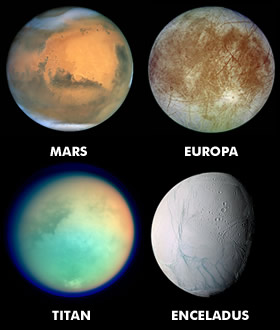Life Elsewhere
12.5 - Understand the requirements for life and the possibility of lifeforms existing elsewhere, including:- a. on Titan
- b. on Europa
- c. on Enceladus
- d. outside our Solar System
Scientists agree that if life (past or present) is to be found elsewhere in the Solar System that it will likely be carbon based and have required water to form and survive. Scientists are interested in water in any form throughout the Solar System.
It is unlikely that life exists in the human or animal forms that we’re familiar with, due to a lack of breathable oxygen or an appropriate position in the Solar System. Instead scientists think life could be microscopic or algae, or dependent on hydrothermal vents on an ocean floor similar to those found in the deepest parts of Earth’s oceans rather than be dependent on the Sun. Life may exists that uses primarily nitrogen or methane instead of oxygen.
Scientists have focused on terrestrial planets and moons in their search for life although some theories exists about life floating in the clouds of Jupiter and Venus that depend on thin clouds of water there.
Titan (satellite of Saturn) possesses a substantial nitrogen rich atmosphere and has lakes of methane on its surface. Huygens found organic compounds on its surface although at a surface temperature of -180°C and lack of liquid water it is unlikely to be a candidate for surface life today. That's not to say better conditions may exist underground or in any lakes on the moon. Until further exploration of the moon and understanding of its chemistry is found, it is unlikely to yield proof of past or present life.
Europa is considered to have a large underground water ocean, as are Ganymede, Callisto (Jupiter Satellites), and Enceladus (Saturn).
Enceladus spews geysers of water into space from its south polar region. Until scientists are able to understand the structure of these bodies and make observations nearer to them, observing or detecting signs if life underneath rock and icy surfaces will be difficult.
Mars is a popular subject for speculation about life. A large ocean is thought to have covered part of the planet and there is recent evidence of some liquid flows on the surface. Probes and artificial satellites scan the planet looking for evidence of past or present life. Probes sent have found water in soil samples (Phoenix Mission). Viking Lander experiments in the 1970s that attempted to find evidence of microbes in the surface were inconclusive. A martian meteorite fragment found in Antarctica caused headlines in the 1990s when bacteria-like structures were found in the rock but the results were controversial and inconclusive.
Outside of our solar system astronomers look for candidate planets in a suitable habitable zone. Planets found so far range from 'Superearths' to 'Hot Jupiters'. Gas giants are not ruled out as they may have terrestrial moons with the right conditions for life. Given the vast numbers of stars and planets in the universe statistically the odds are good that there are many other places in the universe suitable for life to exist. Have a look at the Drake Equation later in this section.
Questions
- Where in the Solar System do scientists hope to detect signs of life and why?
- What are the difficulties associated with searching for life outside of Earth?
Did you know?
Some Astrobiologists believe that life may spread between planets or moons by comets or asteroids – a process called ‘panspermia’.
Links
- Astrobiology.com
- Astrobiology at NASA
- ESA Rosetta
- Wired Top 5 Bets for Extraterrestrial Life in the Solar System




 | © All Rights Reserved |
| © All Rights Reserved |